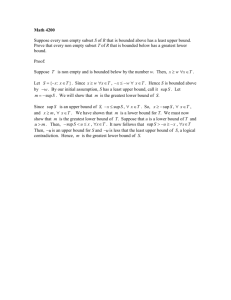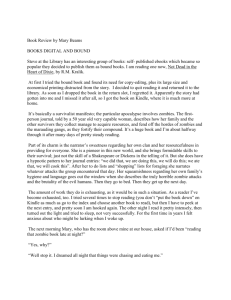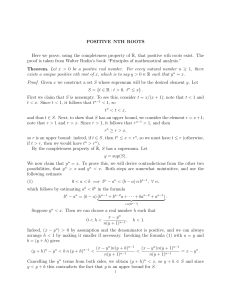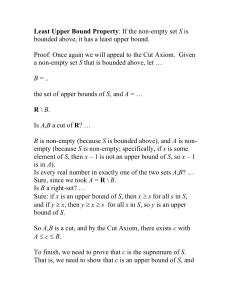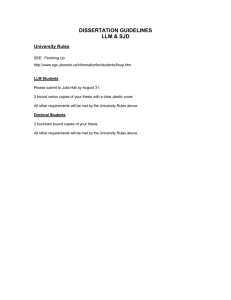MAS221: Characterising Completeness of the Real Number Line
advertisement
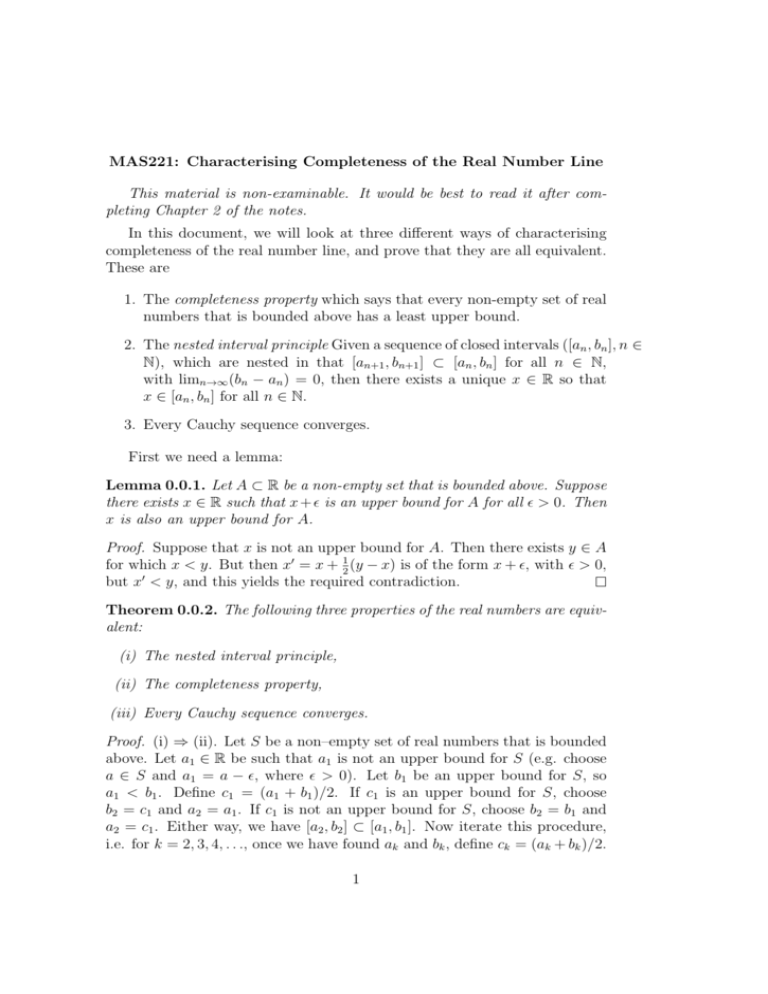
MAS221: Characterising Completeness of the Real Number Line
This material is non-examinable. It would be best to read it after completing Chapter 2 of the notes.
In this document, we will look at three different ways of characterising
completeness of the real number line, and prove that they are all equivalent.
These are
1. The completeness property which says that every non-empty set of real
numbers that is bounded above has a least upper bound.
2. The nested interval principle Given a sequence of closed intervals ([an , bn ], n ∈
N), which are nested in that [an+1 , bn+1 ] ⊂ [an , bn ] for all n ∈ N,
with limn→∞ (bn − an ) = 0, then there exists a unique x ∈ R so that
x ∈ [an , bn ] for all n ∈ N.
3. Every Cauchy sequence converges.
First we need a lemma:
Lemma 0.0.1. Let A ⊂ R be a non-empty set that is bounded above. Suppose
there exists x ∈ R such that x + is an upper bound for A for all > 0. Then
x is also an upper bound for A.
Proof. Suppose that x is not an upper bound for A. Then there exists y ∈ A
for which x < y. But then x0 = x + 21 (y − x) is of the form x + , with > 0,
but x0 < y, and this yields the required contradiction.
Theorem 0.0.2. The following three properties of the real numbers are equivalent:
(i) The nested interval principle,
(ii) The completeness property,
(iii) Every Cauchy sequence converges.
Proof. (i) ⇒ (ii). Let S be a non–empty set of real numbers that is bounded
above. Let a1 ∈ R be such that a1 is not an upper bound for S (e.g. choose
a ∈ S and a1 = a − , where > 0). Let b1 be an upper bound for S, so
a1 < b1 . Define c1 = (a1 + b1 )/2. If c1 is an upper bound for S, choose
b2 = c1 and a2 = a1 . If c1 is not an upper bound for S, choose b2 = b1 and
a2 = c1 . Either way, we have [a2 , b2 ] ⊂ [a1 , b1 ]. Now iterate this procedure,
i.e. for k = 2, 3, 4, . . ., once we have found ak and bk , define ck = (ak + bk )/2.
1
If ck is an upper bound for S, choose bk+1 = ck and ak+1 = ak . If ck is not
an upper bound for S, choose bk+1 = bk and ak+1 = ck . Then we have a
sequence ([an , bn ], n ∈ N) of nested intervals and for all n ∈ N
bn+1 − an+1 = (bn − an )/2 = · · · = (b1 − a1 )/2n → 0 as n → ∞.
So by the nested interval principle, there exists x ∈ R so that an ≤ x ≤ bn
for all n ∈ N.
Given any y < x, we can find m ∈ N so that y < am , for otherwise
an ≤ y < x ≤ bn for all n ∈ N, and this contradicts the uniqueness of x. By
construction of the sequence of an ’s, am cannot be an upper bound for S,
and so neither can y. Given any z > x, we can find k ∈ N so that bk ≤ z, for
otherwise we contradict uniqueness of x, as above. By construction of the
sequence of bn ’s, bk is an upper bound for S and hence so is z. Since every
number larger than x is an upper bound for S, and every number smaller
than x is not an upper bound, we conclude firstly using Lemma 0.0.1 that x
is an upper bound, and secondly that it is the least upper bound.
(ii) ⇒ (iii). Let (an , n ∈ N) be Cauchy and define the set S1 = {a1 , a2 , a3 , . . .}.
Since every Cauchy sequence is bounded (by Problem 41), S1 is a bounded
(non-empty) set of real numbers, and so it has a greatest lower bound L1 .
Now consider the set S2 = {a2 , a3 , a4 , . . .}, i.e. S2 = S1 \ {a1 }. Then S2 is
bounded and its greatest lower bound L2 ≥ L1 . We continue in this fashion,
defining Sk+1 = Sk \ {ak } and Lk+1 = inf(Sk+1 ) for k = 2, 3, . . .. In this
way we obtain a sequence (Ln ) which is monotonic increasing and bounded
above (indeed, any upper bound for S is also a bound for (Ln )). Then (Ln )
converges by Theorem 2.3.1 and we write1 M = limn→ Ln . We will show that
M = limn→∞ an and then (iii) is established.
By Proposition 1.4.2, since M = sup(Ln ), given any > 0, there exists
K ∈ N so that LK > M − . Then since (Ln ) is monotonic increasing
Ln > M − for all n ≥ K. Now since (an ) is Cauchy, there exists N0 ∈ N
so that for all n, m > N0 , |an − am | < 2 . Next let N ≥ max{K, N0 }. Since
LN = inf{aN , aN +1 , aN +2 , . . .}, by Problem 15(b), there exists m > N so that
am < LN + /2.
Now we put all the pieces together. Given our > 0, for all n ≥ N ,
M − < LK ≤ LN ≤ an < am + /2 < LN + ≤ M + ,
i.e. M − < an < M + , and so M = limn→∞ an .
1
In fact, M = lim inf n→∞ an in the language of Problem 40
2
(iii) ⇒ (i).
Let ([an , bn ], n ∈ N) be a sequence of nested intervals. We need to show
that there is a unique x ∈ [an , bn ] for all n ∈ N. First observe that (an ) is a
Cauchy sequence. Indeed since limn→∞ (bn − an ) = 0, given any > 0 there
exists N ∈ N so that bn − an < . But for all m > N ,
am − an ≤ bn − an < ,
and so (an ) is Cauchy. Let x = limn→∞ an . Since the sequence (an ) is
monotonic increasing, and bounded above (e.g. by b1 ), x = supn∈N an ≥ am
for all m ∈ N. We need to show that x ≤ bn for all n ∈ N, Suppose that we
can find k ∈ N so that bk < x. Choose 0 < < x − bk . Since x = limn→∞ an ,
we can find N ∈ N so that n > N ⇒ x − an < . But then bk < ak and we
have a contradiction. Now suppose that y 6= x also satisfies y ∈ [an , bn ] for
all n ∈ N. Either y < x or y > x. If y < x then y is an upper bound for
(an ), which is smaller than x = supn∈N an and that yields a contradiction.
Now suppose y > x. By similar arguments to the above we can show that
x = limn→∞ bn = inf n∈N bn , and we again obtain a contradiction.
If (An , n ∈ N) is a sequence of subsets of a set A, define
\
An = {a ∈ A; a ∈ An for all n ∈ N}.
n∈N
Then,
under the given hypotheses, the nested interval principle tells us that
T
necessarily be true if we replaced closed
n∈N [an , bn ] 6= ∅. This would notT
intervals with open intervals, e.g. n∈N (0, 1/n) = ∅.
3


